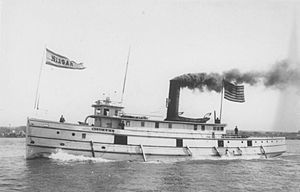Niagara (tug) facts for kids
class="infobox " style="float: right; clear: right; width: 315px; border-spacing: 2px; text-align: left; font-size: 90%;"
| colspan="2" style="text-align: center; font-size: 90%; line-height: 1.5em;" | 
|} The Niagara was a big wooden tugboat that sank on June 4, 1904. It went down in Lake Superior near Duluth, Minnesota. The tugboat hit the ground near Knife River. On April 14, 1994, the wreck of the Niagara was added to the National Register of Historic Places. This means it is an important historical site.
Contents
| History | |
|---|---|
| Name | Niagara |
| Builder | Detroit Dry Dock Company |
| Launched | 1872 |
| In service | 1872 |
| Out of service | June 4, 1904 |
| Identification | U.S. Registry #18714 |
| General characteristics | |
| Type | Tugboat |
| Tonnage |
|
| Length | 130 feet (40 m) |
| Beam | 24.58 feet (7.49 m) |
| Depth | 8.7 feet (2.7 m) |
| Installed power | 560 horsepower fore and aft compound steam engine |
|
|
|
| Location | Lake County, Minnesota |
| Nearest city | Duluth, Minnesota |
| Built | 1872 |
| Architect | Detroit Dry Dock Company |
| Architectural style | Tugboat |
| MPS | Minnesota's Lake Superior Shipwrecks MPS |
| NRHP reference No. | 94000344 |
| Added to NRHP | April 14, 1994 |
About the Niagara Tugboat
The Niagara (Official number 18714) was a special type of tugboat. These tugboats were built to help move huge rafts of timber. They worked on the Great Lakes, which are a group of large freshwater lakes. The lumber industry was very important back then.
The Niagara was built in 1872 by the Detroit Dry Dock Company. It was 130 feet (about 40 meters) long. Its width was 24.58 feet (about 7.5 meters). The depth of its hull was 8.7 feet (about 2.6 meters).
This tugboat was important for its role in the Great Lakes lumber business. It helped transport wood across the lakes.
Upgrades and New Engine
In 1889, the Niagara was rebuilt and got new parts. It received a powerful new engine. This engine was a 560-horsepower Compound steam engine. It was built by the Frontier Engine Works Company in Detroit.
The tugboat also got a new Scotch marine boiler. This boiler was 13 feet (about 4 meters) wide and 13 feet (about 4 meters) high. It was built by Thomas McGregor, also from Detroit.
The Niagara's Last Trip
On June 4, 1904, the Niagara was sailing from Sault Ste. Marie, Michigan. It was heading to Duluth, Minnesota. Its job was to pick up some construction equipment. This equipment belonged to a company called Hugo & Tims.
The weather was very bad during its trip. The tugboat ran aground, meaning it hit the bottom, near Knife Island. The crew said their compass stopped working. They believed it was confused by magnetic signals from the shoreline.
The captain tried to reverse the engine. But strong winds and big waves pushed the tugboat onto the rocks. The Niagara began to break apart very quickly.
Rescue at Knife River
Distress calls from the Niagara were heard in a nearby village. This village was at the mouth of Knife River. The telegraph operator there quickly sent a message. They asked for help from the town of Two Harbors, Minnesota.
The steel tugboat Edna G was sent to rescue the crew. It arrived quickly to help. The Edna G saved all eleven crewmen and two passengers. Only one person, Mrs. A. Merritt, was hurt. She cut her hand while getting out of her cabin.
On June 16, 1904, the Duluth Evening News reported on the Niagara. The newspaper said the tugboat was quickly taken apart. Its boiler, engine, and other metal parts were removed. These parts were then stored at the Whitney Brother's dock in Duluth.
The Niagara Shipwreck Site
The wreck of the Niagara lies in four main pieces. It rests on a rocky slope near Knife Island. The parts include the front of the boat (stem), parts of its sides, and a piece of its railing.
The back part of the boat (stern) is missing. It might have been taken during a rescue attempt. Or it could be lying far away from the other pieces. A small part of the deck is still attached to one side.
The Niagara is a special shipwreck. It is one of only two known tugboats used for rafting found in the Minnesota part of Lake Superior. The other one is the Bob Anderson, built in 1862.



